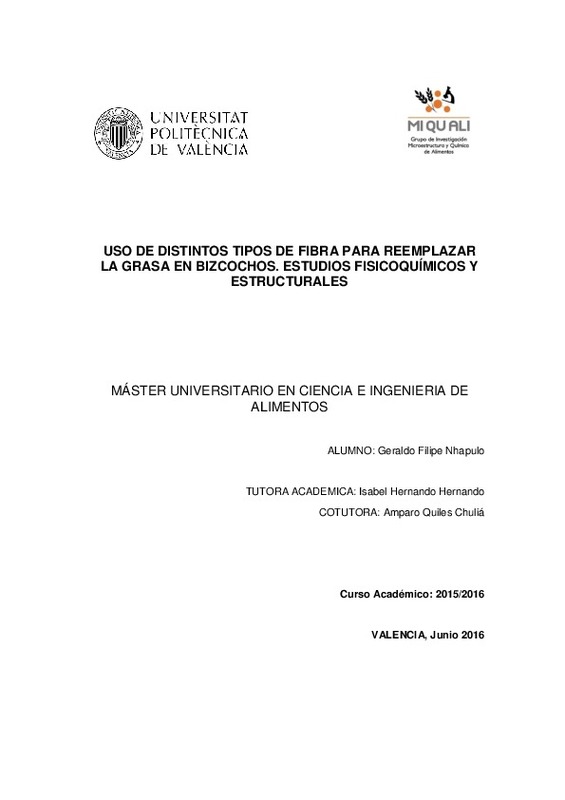|
Resumen:
|
[ES] En este trabajo se evaluó el efecto que tiene la sustitución de un 30% de
grasa en bizcochos, por ingredientes ricos en fibra, sobre la estructura y
propiedades fisicoquímicas de las masas y de los respectivos ...[+]
[ES] En este trabajo se evaluó el efecto que tiene la sustitución de un 30% de
grasa en bizcochos, por ingredientes ricos en fibra, sobre la estructura y
propiedades fisicoquímicas de las masas y de los respectivos bizcochos. En
las diferentes formulaciones, se determinó la viscosidad aparente y se
simuló el microhorneado de las masas. Se ejecutaron ensayos de perfil de
textura y se analizó la estructura de la miga. Se estudiaron las distintas
fracciones de digestibilidad del almidón y la liberación de glucosa mediante
estudios de digestión in vitro. Los resultados, indicaron un descenso
significativo (P<0,05) de la viscosidad aparente de las masas elaboradas con
fibra, originando una mayor incorporación de burbujas de aire y menor
estabilidad que en las masas control. Esto llevó a una mayor aparición de
canales de difusión en la estructura de la miga y a un aumento significativo
(P<0,05) del porcentaje de aire en la misma sección de los correspondientes
bizcochos. Además, se registró un aumento significativo (P<0,05) en la
dureza, gomosidad, y elasticidad de los bizcochos. No se encontraron
diferencias significativas (P>0,05) en las fracciones RDS e SDS de
digestibilidad de almidón, pero sí en la fracción RS y en la liberación de
glucosa a los 180 min. La fibra soluble afectó menos la estructura y
características de los bizcochos que la insoluble; por lo tanto, la grasa puede
ser sustituida en un 30% por este tipo de fibra, para obtener bizcochos bajos
en grasa, con menos calorías y con fibra alimentaria añadida.
[-]
[EN] This study evaluated the effects of 30% of fat replacement in cakes by
ingredients rich in fiber on the structure and physicochemical properties of
the batters and the respective cakes. The apparent viscosity was ...[+]
[EN] This study evaluated the effects of 30% of fat replacement in cakes by
ingredients rich in fiber on the structure and physicochemical properties of
the batters and the respective cakes. The apparent viscosity was determined
and a microbaking of the batters was simulated in the different formulations.
Texture profile tests were carried out and the crumb structure was analyzed.
The different digestibility fractions of starch and glucose release were studied by in vitro digestion studies. The results showed a significant decrease
(P<0.05) of the apparent viscosity values of the fat-replaced batters, causing
high incorporation of air bubbles and with less stability if compared to control.
This fact led to an increased occurrence of channels in the crumb structure
and a significant increase (P<0.05) of the percentage of air in the respective
cakes. In addition, a significant increase (P<0.05) in hardness, gumminess,
and springiness of the cakes was observed. There were no significant
differences (P>0.05) in the RDS and SDS fractions of starch digestibility, but,
significant differences in RS and glucose release at 180 min were found.
Soluble fiber affected less the structure and characteristics of the cakes than
insoluble fiber, therefore, 30% of the fat can be replaced by this type of fiber
to obtain low fat cakes, with less calories and cakes added dietary fiber.
[-]
[CA] En este treball es va avaluar l'efecte que té la substitució d'un 30% de
greix en bescuits per ingredients rics en fibra sobre l'estructura i propietats
fisicoquímiques de les masses i dels respectius bescuits. En ...[+]
[CA] En este treball es va avaluar l'efecte que té la substitució d'un 30% de
greix en bescuits per ingredients rics en fibra sobre l'estructura i propietats
fisicoquímiques de les masses i dels respectius bescuits. En les diferents
formulacions, es va determinar la viscositat aparent i es va simular el
microenfornat de les masses. Es van executar assajos de perfil de textura i
es va analitzar l'estructura de la molla. Es van estudiar les distintes fraccions
de digestibilitat de midó i l'alliberament de glucosa per mitjà d'estudis de
digestió in vitro. Els resultats, van indicar un descens significatiu (P<0,05) de
la viscositat aparent de les masses elaborades amb fibra, originant una
major incorporació de bambolles d'aire i amb menor estabilitat que en les
masses control. Açò va portar a una major aparició de canals de difusió en
l'estructura de la molla i un augment significatiu (P<0,05) de percentatge
d'aire en la mateixa secció dels corresponents bescuits. A més, es va
registrar un augment significatiu (P<0,05) en la duresa, gomositat, i elasticitat
dels bescuits. No es van trobar diferències significatives (P>0,05) en les
distintes fraccions de digestibilitat de midó, però sí en l'alliberament de
glucosa als 180 min. La fibra soluble va afectar menys l'estructura i
característiques dels bescuits que la insoluble; per tant, el greix pot ser
substituït en un 30% per este tipus de fibra, per a obtindre bescuits baixos en
greix, amb menys calories i amb fibra alimentària afegida.
[-]
|







